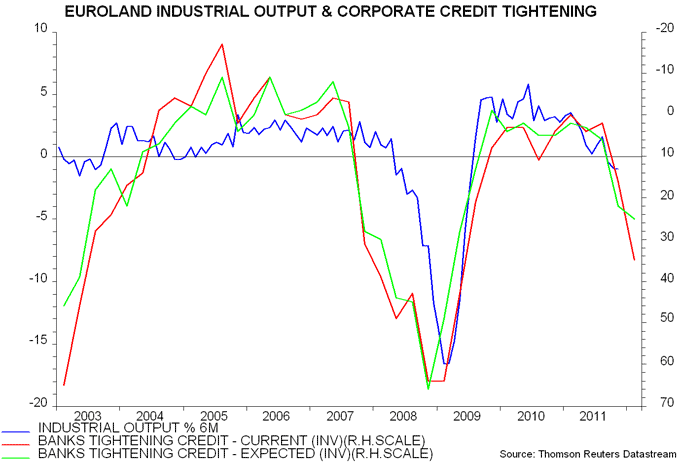Eurozone credit crunch eased by ECB lending boost
The ECB’s latest bank lending survey confirms a significant tightening of credit conditions but forward-looking components are marginally less grim, probably reflecting the ECB’s three-year lending operation.
The net percentage of banks tightening credit standards on business loans rose to 35% last quarter, the highest since 2009 and similar to the level in early 2008 before a collapse in industrial output – see chart. This confirms a message of weakness from last week’s monetary data – see previous post.
The balance planning to tighten standards in the current quarter, however, was lower, at 25%, reflecting an expectation of less difficult wholesale funding conditions following the ECB’s decision to extend the maturity of its liquidity support and loosen collateral requirements further. Banks, presumably, will have been encouraged by a thawing of markets since the survey was conducted in late December / early January, with the key three-month LIBOR / OIS spread subsiding from more than 90 to below 70 basis points.


Reader Comments (2)
Hi Simon,
Continue to enjoy the blog! A question for you. Out of real narrow money and the lending survey (or components of), which has the longer lead on real activity, and are the correlations of a similar standard? Thanks!
Thanks Rob - interesting question. The ECB lending survey started in 2003 so there is insufficient history for a comparison. However, the equivalent US survey goes back to 1967 (with a break of a few years in the 1980s). The US data suggest that 1) the credit tightening balance is a good leading indicator, 2) real narrow money is slightly more reliable and sometimes exhibits a longer lead and 3) recessions are normally signalled by the tightening balance moving well above +30%. On this basis, the Eurozone current balance is in recessionary territory but the future one isn't - consistent, perhaps, with a mild downturn, which is also suggested by the real M1 data.